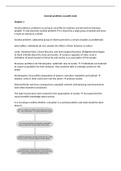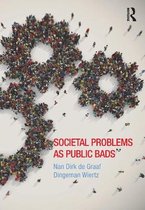Societal problems as public bads
Chapter 1
Social problems: problems occurring in social life (in relations and interactions between
people) only becomes societal problem if it is shared by a large group of people and leave
a mark on society as a whole
Societal problem: substantial group of citizens perceives a certain situation as problematic
Externalities: individuals do not consider the effects of their behavior on others
Locke, Immanuel Kant, Cesare Beccaria, and Jean-Jacques Rousseau (Enlightenment) began
to think critically about the state and society society is opposite of state; state is
institution of power based on hierarchy and society is an association of free people
Rousseau and Baron de Montesquieu: optimistic view of society if individuals surrendered
to reason as guideline for their behavior, they would be able to redesign society for the
better
Montesquieu: trias politica (separation of powers: executive, legislative and judicial)
balance; none of them could over-rule the others protects society
Edmund Burke: perverse consequences; plausible schemes with pleasing commencements
have often shameful conclusions
The state has become more involved in the organization of society increased need for
social scientific knowledge about society
It is not always evident whether a situation is a societal problem and what should be done
about it
, 1. Societal problems often originate from an aggregation of individual-level behaviors
that cause unintended consequences at the society level
2. Societal problems must be recognized as a societal problem; detection and
evaluation (people need to be aware of the situation and consider it to conflict with
important values) only when there is a sharp conflict with dominant values, there
is a societal problem
3. Societal problems need to be perceived as important by a large portion of the
population to put a problem on the public agenda influence is needed. Social
media makes it easier to put something on the public agenda
4. Societal problems can be resolved by collective action or the government (free rider
problem). States become interventionist states
Politicians sometimes push aside societal cost-benefit trade-offs in favor of electoral
considerations; political business cycle short-termism neglect of longer-term issues
Social norms can be considered a public good; James Coleman: social norms are form of
social capital (productive asset for a group, from which each individual member can benefit)
social norms make behaviors more predictable fewer problems in interactions
becomes easier to trust each other
Immanuel Kant’s categorical imperative: people should behave in such a way that one’s
behavior could serve as the basis for general legislation treat others as one would like
others to treat oneself
John Rawls (progressive or egalitarian liberal social theory): state should play a major
coordinating role in guaranteeing citizens’ fundamental rights; people need to think of their
original position (before you were born into this world) individuals do not know their
characteristics and their ‘veil of ignorance’ will disappear individuals will then not choose
principles that would benefit them at the expense of their rivals. Principle of liberty: every
citizen should be guaranteed a set of basic liberties. Difference principle: inequalities among
citizens should be permitted so long as everyone faces equal opportunities to access
different positions (fair equality of opportunity principle) and so long as they are
advantageous to those who are least well of (maximim principle)
Robert Nozick (libertarian social theory/classical liberalism): power and scope of the state
should be strictly limited (night-watchman state); just principles are those that maximize the
liberty of the individual to live by his own values negative liberties (natural rights
concerning non-interference by outsiders) and non-aggression principle (immoral to use
force against another person) if there is no coercion or force involved, everything is
allowed. Citizens do not possess any positive liberties (right to health care, home, certain
standard of living)
Liberals: individual as focal point; individual rights and freedoms prefer state to intervene
as little as possible in the market outcomes
Socialists: larger role government; respecting and protection of individuals’ freedoms and
facilitating improvements in individuals’ living conditions
,Conservatives: pragmatic rather than abstract arguments and experience rather than reason
reject rationalism and universalism emphasize wisdom and experience embodied in
long-standing social institutions caution against rapid social change, preferring gradual
reform prioritize order and stability over equality or liberty
These spheres are connected to one another.
Excludability: if it is possible to prevent people from consuming that good
Rivalry: someone’s consumption of that good reduces other people’s opportunities to
consume it
The provision of public goods requires collective action in general free riding (individuals
benefit regardless of whether they participate)
Garrett Hardin: tragedy of the commons; rational and profit-maximizing people will cause
eventual exhaustion of the common-pool resource because everyone wants the same
Robert Putnam: social capital are features of social organization such as networks, norms,
and social trust that facilitate coordination and cooperation for mutual benefit facilitates
smooth interpersonal contacts; resource of productive value. Social capital: non-
excludability and non-rivalry public good and it also helps producing other public goods
James Coleman: social capital are those aspects of social structure that can be used as
resources by individuals to realize their personal interests obligation to return favors
, Social networks: social control maintaining social norms. What a single individual can’t do
alone, actors within a social network can do together, while ensuring others with
agreements, rules, and norms. Negative: individuals may be strongly attituded against non-
members
Chapter 2
Macro-micro-macro framework: individual actions as starting point for explanations of
phenomena at the societal level
Descriptions: statements of a qualitative or quantitative nature that characterize the
phenomenon (simply describing a phenomenon)
Explanations: revealing underlying determinants and causal forces
Macro-micro-macro model (actor-in-context approach, Coleman’s boat, Coleman’s bathtub):
macro-level conditions influence the micro-level conditions in which individual actors
operate, shaping their opportunity structure micro-level conditions, preferences, and
objectives result in micro-level outcomes; aggregation of micro-level outcomes macro-
level outcomes. Macro-level conditions micro-level processes macro-level outcomes
Hog cycle phenomenon: macro level: supply is low, and price is high micro level: suppliers
observe information and make decisions about their future behavior increase stock, so
they can sell more at the higher price and make more profit macro-level: every supplier
will think in this way, higher surplus of stock will make the prices drop suppliers will leave
market/decrease their production shortage of stock higher prices
Methodological individualism: using micro-level behaviors to explain the macro-level
phenomena individuals can be considered as things with a will and a capacity to act
purposefully; aggregations of individuals do not possess their own will or their own
objectives and can only take actions when their members have agreed upon a course to
follow (Max Weber and Georg Simmel)
Social situations: two or more participants, who interact with each other, try to influence
each other, try to outsmart each other, or who adapt their decisions to those of the other
contextual influences shape people’s motives, desires, preferences, and people’s
opportunities to act on these motives, desires, and preferences choices made by the
same individuals can vary from one social context to another






